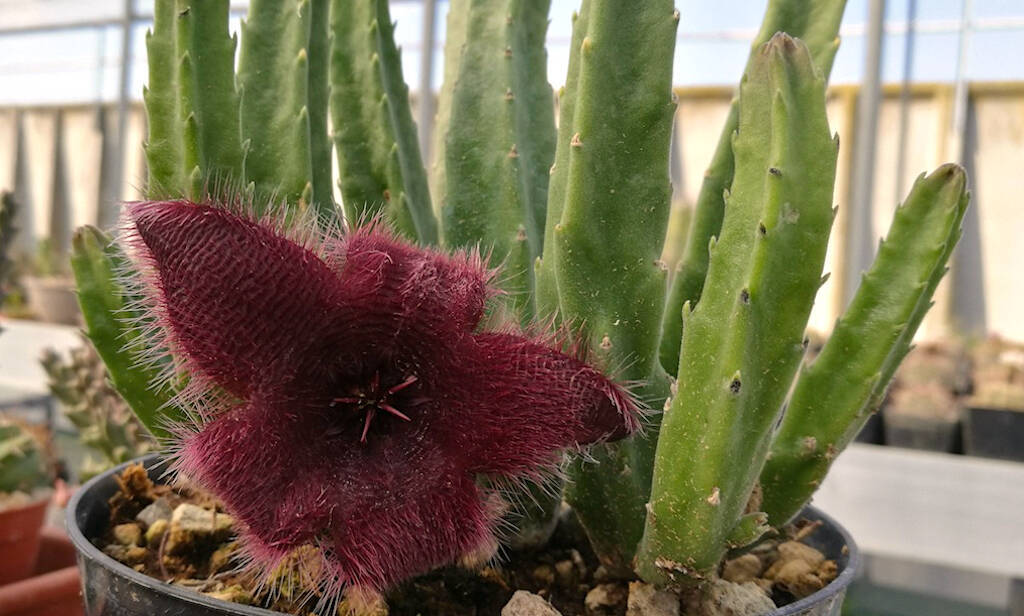Although more than twenty years have passed, I still remember my first encounter with an Asclepiadaceae. A few years ago, I approached the world of succulents, and I went to visit a nursery just outside my city. I had been browsing among the succulents for quite a while when the owner of the nursery, an elderly but very chirpy lady, noticed me and my interests in plants, approached me and said: “Do you want to see a succulent plant with beautiful flowers?” I said yes, of course, I wanted to see it, so she took me down a narrow corridor cluttered with plants and pointed to a large succulent in a hanging pot. It had thick fleshy, straight green stems with reddish edges, and from one of these stems hung a big star-shaped flower with elongated, thin tips and shaded yellow petals crossed by tiny dark streaks. “Come closer, sniff how good it smells”, the lady said to me, passing from a restrained smile to an open, fat laugh, as soon as I obeyed and immediately withdrew, disgusted by the smell of rotting flesh that from that flower had entered right into my nose.
Keep on reading the article if you want to know how this story goes (…)
Well, if on the one hand, I would still like to see my expression immediately after having smelled that flower, on the other hand, the joke of that nurserywoman has forever imprinted in my memory my first encounter with a Stapelia (in this case a Stapelia gigantea), but above all with its flower, as beautiful and showy as it’s terrible, disgusting in terms of smell. And on the other hand, this is the main characteristic of almost all the plants belonging to the Asclepiadaceae family: their flowers, be they the small ones of the Piaranthus or the huge ones of certain Stapeliads, have a terrible smell. The smell they give off is that of rotting flesh, in particular, and there’s a specific reason Nature has chosen this for them.
Let’s see why this large family of succulents is condemned to produce flowers with beautiful shapes, incredible streaks and yet terribly smelly. Let’s get to know better the Asclepiadaceae, the various genera belonging to this family native to Africa and let’s learn how to correctly cultivate its species.
Origin and provenance
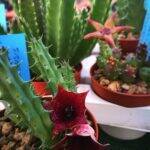
The Asclepiadaceae family includes about two thousand species and almost 250 genera, a quarter of which are succulents. In the last years, the classification has changed the Asclepiadaceae family to a subfamily included in the Apocynaceae family, but for convenience and brevity, I will write here of “family” referring to the Asclepiadaceae. First of all, it must be said that not all Asclepiadaceae are succulent plants: in this large family, you can find herbaceous plants, leafy plants, bushes, trees and even lianas. The origin of these plants is mainly African, in particular the temperate, tropical, subtropical and desert regions of the African continent. However, their distribution is not limited to Africa: some genera of the Asclepiadaceae family are native to the American continent, others to the Arabian Peninsula to China, and others to Oceania. Finally, two species are of European origin: Caralluma mumbyana and Caralluma europaea, actually native to the extreme South of Italy (Lampedusa) and North Africa (Morocco, Tunisia, Libya).
Maps with the distribution of succulents in the world.
Flowers are of various sizes and go from the few centimetres of Hoya to the huge ones, up to about thirty centimetres, of Stapelia gigantea, but they are always star-shaped, with five sepals and five petals joined together at the base.
The most known and cultivated genera
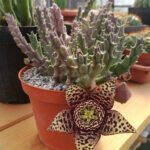
As for the lovers of succulent plants, the most appreciated and cultivated Asclepiadaceae belong to the group (or “tribe”) of Stapeliae. In this group are included: the genera Stapelia, Caralluma, Duvalia, Echidnopsis, Frerea, Hoodia, Huernia, Orbea, Piaranthus, Pseudolithos, Tavaresia, Whitesloanea. Among the Asclepiadaceae not belonging to the Stapeliae group, more cultivated by the lovers of succulents, there’re Hoya (the epiphytic plant with “wax flowers”), Ceropegia and Fockea. The species of the group Stapeliae are almost all characterized by fleshy stems and tufty posture. In some cases, they develop proper succulent branches, in others, they form rounded or short-cylindrical “articles” (as with the genus Piaranthus). In other cases, the stem is like a sculpture, similar to a small monolith or a rock (e.g. Pseudolithos and Whitesloanea). Totally different is instead the posture of Hoya, which develops very long stems from which fleshy, thick leaves come out. Ceropegia has a similar appearance, while Fockea forms big brown caudex (caudex is basically the thick and wide stem) from which long branches with small, not fleshy, leaves of an intense green colour branch out.
Why do the flowers smell?
Let’s start by saying that not all the flowers of the Asclepiadaceae deserve the nickname of “carrion flower” or “stinky plant”, with which Stapelia flowers are usually associated. Many flowers of plants belonging to this family produce perfume or ugly odour, as in the case of Hoya, whose flowers grouped in clusters have a beautiful shiny appearance, perfect, to be defined as “of wax”. Same for the flowers of Fockea, not very evident and without any particular smell or fragrance. They certainly deserve the definition of “carrion flower” many other genera, almost all belonging to the group Stapeliae, particularly the flowers of Stapelia and those of Piaranthus.

Why this curse? Why do such showy, beautiful and colourful flowers give off the smell of rotting flesh? Simply because the pollinating insects of these plants are flies, and it’s to these insects that these plants rely on to multiply. The most emblematic example is Stapelia hirsuta (the plant you can see above, under the title), which produces large star-shaped flowers, blood-red in colour to recall the colour of meat, and smelly, just like rotting flesh. The flies are strongly attracted to it: they pass from one flower to another just as bees do with any flower, pollinate the Stapelia and lay their larvae inside the flower, which, however, drying up, will prove to be a deadly trap for the larvae themselves, condemned to die inside the closed flower. If the smell of rotten meat is typical of the species of the genus Stapelia, many other Asclepiadaceae produce smell even if with different “fragrances”, as in the case of Piaranthus, Orbea and Pseudolithos, just to mention a few. Finally, as for the flowering period, almost all the Stapelia‘s plants group flower in autumn until the beginning of winter. An element, this one, which can interest those who want to enjoy blooming for almost the whole year, if they place side by side to the cultivation of Cactaceae the cultivation of Asclepiadaceae.
Cultivation regime
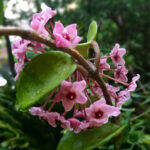
Staying in the Stapeliae group, which is of interest to succulent growers, it should be noted that Asclepiadaceae need a very different cultivation regime than the one effective for Cactaceae. Firstly concerning the minimum winter temperatures, which should be kept under control so that Asclepiadaceae do not go down 7-8 Celsius degrees. Fundamental, as for cacti, is that the plants remain in full dry soil from October to the end of March. If we see that the stems begin to lose too much turgidity, we can give little water on sunny days. I recover my Asclepiadaceae in an unheated cellar, with minimum temperatures between 6-8 degrees. At night, in the greenhouse, it can go down to 0 degrees, and I prefer not to risk it. Even about the exposure, the differences with most of the Cactaceae are of relief. The Asclepiadaceae of the group Stapeliae do not go exposed to the direct sun if not in the morning. From when the sun gets warmer, around midday, the plants should be sheltered in a greenhouse or by a shading net or, again, placed behind plants and shrubs that can give them shade. If kept in too much sun, Stapeliae suffers, slow down their vegetation and become extremely red. In summary: give them lots of light but not direct sun.
Watering should be done only from the end of March to the end of October but without exaggerating because these plants are sensitive to water stagnation and environmental humidity. Watering should be reduced, therefore, and the soil should be very draining. About the substrate, some grow Asclepiadaceae succulents in mineral soil, without organic (peat or humus), mixing pumice, zeolite, akadama, gravel, etc… Other growers keep them in only pumice, which promotes rooting and retains excess water by releasing it little by little. I’ve been growing these plants in the usual mix of equal parts peat, pumice, and lapilli, but I’m gradually switching to pumice alone, which requires more frequent fertilizing because it doesn’t provide much in the way of nutrients. Alternatively (as I did in the video at the end of this article), you can use a substrate made of pumice with the addition of a few humus (10%) and not much sand to give a minimum of nutrients and to add a good part to the compost, which with only pumice would be too coarse.
The soils to use with succulent plants.
In his book, Giuseppe Lodi advised to grow the Asclepiadaceae “in rather oily soil, but very permeable and sandy at the top”. He suggests it just to ensure that the collar does not remain wet for too long, being easily subject to rot. Always noted Lodi: “It is advisable to put a rich layer at the bottom (more leaf mould than sand and soil), then an intermediate layer with more sand and an upper one even more sandy” (Giuseppe Lodi, “Le mie piante grasse” – Edagricole).
For the rest, the cultivation rules indicated for most succulents are valid: as much air as possible and sparing fertilizations with specific products for succulents only during the vegetative season.
Main adversities
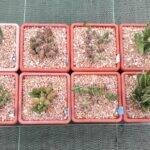
Collar rot and cochineal mealybug are the main problems in the cultivation of succulent Asclepiadaceae. To preventing rottenness, it’s advisable to moderate watering, use correct substrates and give as much air as possible to our plants. Against mealybug, the same cares are more or less valid since proper cultivation is the best prevention. Also, as a preventive measure, it’s possible to use specific products in particular periods. A few passes of copper oxychloride by spraying the stems at the end of the growing season and just before spring, for example, and Neem oil, again by showering during the warmer months (here a specific article). Against mealybug, some recommend inserting two or three balls of mothballs in the soil, a little deep. I have never tried this method, but I have heard of it several times.
Propagation
The multiplication of Asclepiadaceae can be done, as always, by seed or by cuttings. Seeding is necessary for those kinds of plants that do not branch, such as Trichocaulon and Whitesloanea, while cutting is the fastest method to reproduce genera such as Stapelia, Orbea, Caralluma, etc… It’s enough to cut a branch with a sharp cutter, let it dry for a couple of weeks in an airy place, sheltered from the sun and then place it on pumice with a superficial layer of sand. At that point, it’s possible to nebulize the stem and the substrate’s surface once every two or three days, thus favouring the rooting of the cutting. Obviously, reproduction by cuttings must be done during the vegetation period, therefore from late spring onwards and never in winter. Moreover, to avoid rottenness, it is better to sprinkle with copper oxychloride powder both the mother plant in the point where the branch has been cut and the cutting itself.
SUBSCRIBE TO THE SITE – If you liked this article, subscribe to the site to have access to all the contents for one year or three months depending on the formula you choose. Here you will find terms and conditions.
SUBSCRIBE TO THE NEWSLETTER – If you want to receive the free newsletter every time new content is published (even if you have not subscribed to the site), fill in the fields at this link!
Repotting of Asclepiadaceae: the video
© The texts, videos, photos and graphic elaborations of the site “Il fiore tra le spine” are original material and are covered by copyright. It’s forbidden to reproduce them in any way.


